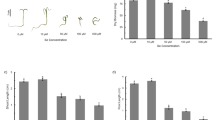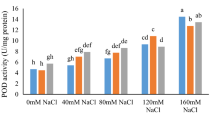Abstract
The medicinal plant, Plantago asiatica have high selenium (Se) accumulation ability but is considered lower compared to other Se-hyperaccumulators. In this experiment, we evaluated the effects of different amino acid concentrations (600, 900, 1200, and 1500-fold dilutions) on the growth and Se uptake in P. asiatica for possible improvement of Se accumulation ability and medicinal value of P. asiatica. The 600, 900, and 1200-fold amino acid dilutions increased the root and shoot biomass of P. asiatica. Additionally, the photosynthetic pigments contents (chlorophyll a, chlorophyll b, and total chlorophyll) and antioxidant enzymes activities (superoxide dismutase, peroxidase, and catalase) of P. asiatica were increased by the different amino acid concentrations. However, these amino acid concentrations reduced the soluble protein content of P. asiatica to some extent. The Se content and extraction from P. asiatica were also enhanced and had a quadratic polynomial regression relationship with the Se extraction tissues and their Se contents. In addition, there were significant correlations between the biomass of Se extraction tissues and their Se contents. Our findings indicate that various amino acid concentrations promote growth and Se uptake in P. asiatica, but 900-fold amino acid dilution is the best concentration for enhancing Se accumulation ability in P. asiatica shoots.





Similar content being viewed by others
References
Abd El-Aal FS, Shaheen AM, Ahmed AA, Mahmoud AR (2010) Effect of foliar application of urea and amino acids mixtures as antioxidants on growth, yield and characteristics of squash. Res J Agric Biol Sci 6(5):583–588
Alfosea-Simón M, Simón-Grao S, Zavala-Gonzalez EA, Cámara-Zapata JM, Simón I, Martínez-Nicolás JJ, Lidón V, García-Sánchez F (2021) Physiological, nutritional and metabolomic responses of tomato plants after the foliar application of amino acids aspartic acid, glutamic acid and alanine. Front Plant Sci 11:581234
Ali Q, Ashraf M, Shahbaz M, Humera H (2008) Ameliorating effect of foliar applied proline on nutrient uptake in water stressed maize (Zea mays L.) plants. Pak J Bot 40(1):211–219
Ali S, Abbas Z, Seleiman MF, Rizwan M, YavaŞ İ, Alhammad B, Shami A, Hasanuzzaman M, Kalderis D (2020) Glycine betaine accumulation, significance and interests for heavy metal tolerance in plants. Plants 9(7):896
An MY (2017) Study on the main influencing factors of Selenium morphological transformation in Selenium-rich soil and its effect on crop absorption. Fujian Agriculture and Forestry University, Fujian
Astaneh RK, Bolandnazar S, Nahandi FZ, Oustan S (2018) The effects of selenium on some physiological traits and K, Na concentration of garlic (Allium sativum L.) under NaCl stress. Inf Process Agric 5(1):156–161
Bahari A, Pirdashti H, Yaghubi M (2013) The effects of amino acid fertilizers spraying on photosynthetic pigments and antioxidant enzymes of wheat (Triticum aestivum L.) under salinity stress. Int J Agron Plant Prod 4(4):787–793
Bao J, Liu JX, Chen FJ, Zhang FS, Mi GH (2009) roles of phytohormones in nitrogen-and phosphorus-regulated root morphogenesis. Plant Physiol Commun 45(7):706–710
Causin HF (1996) The central role of amino acids on nitrogen utilization and plant growth. J Plant Physiol 149(3–4):358–362
Chauhan R, Awasthi S, Tripathi P, Mishra S, Dwivedi S, Niranjan A, Mallick S, Tripathi P, Pande V, Tripathi RD (2017) Selenite modulates the level of phenolics and nutrient element to alleviate the toxicity of arsenite in rice (Oryza sativa L.). Ecotoxicol Environ Saf 138:47–55
Chauhan R, Awasthi S, Srivastava S, Dwivedi S, Pilon-Smits EAH, Dhankher OP, Tripathi RD (2019) Understanding selenium metabolism in plants and its role as a beneficial element. Crit Rev Environ Sci Technol 49:1937–1958
Chiang LC, Chiang W, Chang MY, Lin CC (2003) In vitro cytotoxic, antiviral and immunomodulatory effects of Plantago major and Plantago asiatica. Am J Chin Med 31(02):225–234
Feng R, Wei C, Tu S (2013) The roles of selenium in protecting plants against abiotic stresses. Environ Exp Bot 87:58–68
Gapper C, Dolan L (2006) Control of plant development by reactive oxygen species. Plant Physiol 141(2):341–345
Hao ZB, Cang J, Xu Z (2004) Plant physiology experiment. Harbin Institute of Technology Press, Harbin
Häusler RE, Ludewig F, Krueger S (2014) Amino acids—a life between metabolism and signaling. Plant Sci 229:225–237
Hawkesford MJ, Zhao FJ (2007) Strategies for increasing the selenium content of wheat. J Cereal Sci 46(3):282–292
Hildebrandt TM, Nesi AN, Araújo WL, Braun HP (2015) Amino acid catabolism in plants. Mol Plant 8(11):1563–1579
Hou Y, Yin Y, Wu G (2015) Dietary essentiality of “nutritionally non-essential amino acids” for animals and humans. Exp Biol Med 240(8):997–1007
Khalil AA, Osman EAM, Zahran FAF (2008) Effect of amino acids and micronutrients foliar application on onion growth, yild and its components and chemical chracteristics. J Soil Sci Agric Eng 33(4):3143–3150
Khan S, Yu H, Li Q, Gao Y, Sallam B, Wang H, Liu P, Jiang W (2019) Exogenous application of amino acids improves the growth and yield of lettuce by enhancing photosynthetic assimilation and nutrient availability. Agronomy 9(5):266
Li P, Yin YL, Li D, Kim SW, Wu G (2007) Amino acids and immune function. Br J Nutr 98(2):237–252
Li M, Xiang G, Du Y, Wang Y, Peng Y (2008) Effects of different concentrations of amino acid phytonutrients on germination and seedling growth of kidney bean. South China Agric 04:10–11
Liang X, Cao X, Zhang R, Liu J, Wang A (2021) Effects of different sorghum and soybean intercropping patterns on yield, water and nutrient use efficiency. Acta Agric Boreali-Sin 36(3):174–184
Liao R, Huang K, Li K (2018) Study on selenium enrichment characteristics of medicinal plant Plantain plantago L. J Chin Med Mater 41(2):276–279
Lin CC, Kan WS (1990) Medicinal plants used for the treatment of hepatitis in Taiwan. Am J Chin Med 18(01–02):35–43
Lin L, Sun J, Cui T, Zhou X, Liao M, Huan Y, Yang L, Wu C, Xia X, Wang Y, Li Z, Zhu J, Wang Z (2020a) Selenium accumulation characteristics of Cyphomandra betacea (Solanum betaceum) seedlings. Physiol Mol Biol Plants 26(7):1375–1383
Lin L, Wu C, Jiang W, Liao M, Tang Y, Wang J, Lv X, Liang D, Xia H, Wang X, Deng Q, Wang Z (2020b) Grafting increases cadmium accumulation in the post-grafting generations of the potential cadmium-hyperaccumulator Solanum photeinocarpum. Chem Ecol 36(7):685–704
Lithander A (1992) Intracellular fluid of waybread (Plantago major) as a prophylactic for mammary cancer in mice. Tumor Biol 13(3):138–141
Liu W, Xie B, Ni G, Deng G (2011) Effects of gibberellin and amino acids on the growth of branches and leaves of Syzygium grijsii. Bull Bot Res 31(2):218–226
Liu L, Han J, Deng L, Zhou H, Bie Y, Jing Q, Lin L, Wang J, Liao M (2021) Effects of diethyl aminoethyl hexanoate on the physiology and selenium absorption of grape seedlings. Acta Physiol Plant 43(8):1–8
Ma Y (2006) Biological characteristics and cultivation techniques of Plantain plantago L. J Henan Agric Sci 9:109–110
Noroozlo YA, Souri MK, Delshad M (2019) Stimulation effects of foliar applied glycine and glutamine amino acids on lettuce growth. Open Agric 4(1):164–172
Pilon-Smits EAH, Quinn CF, Tapken W, Malagoli M, Schiavon M (2009) Physiological functions of beneficial elements. Curr Opin Plant Biol 12(3):267–274
Rai VK (2002) Role of amino acids in plant responses to stresses. Biol Plant 45(4):481–487
Rastmanesh F, Moore F, Keshavarzi B (2010) Speciation and phytoavailability of heavy metals in contaminated soils in Sarcheshmeh area, Kerman Province, Iran. Bull Environ Contam Toxicol 85(5):515–519
Rayman MP (2000) The importance of selenium to human health. The Lancet 356(9225):233–241
Rayman MP (2012) Selenium and human health. The Lancet 379(9822):1256–1268
Slekovec M, Goessler W (2005) Accumulation of selenium in natural plants and selenium supplemented vegetable and selenium speciation by HPLC-ICPMS. Chem Speciat Bioavailab 17(2):63–73
Souri MK, Hatamian M (2019) Aminochelates in plant nutrition: a review. J Plant Nutr 42(1):67–78
Souri MK, Yaghoubi SF, Moghadamyar M (2017) Growth and quality of cucumber, tomato, and green bean plants under foliar and soil applications of an aminochelate fertilizer. Hortic Environ Biotechnol 58(6):530–536
Tantawy A, Abdel-Mawgoud AMR, El-Nemr MA, Chamoun YG (2009) Alleviation of salinity effects on tomato plants by application of amino acids and growth regulators. Eur J Sci Res 30(3):484–494
Teixeira WF, Fagan EB, Soares LH, Umburanas RC, Reichardt K, Dourado-Neto D (2017) Foliar and seed application of amino acids affects the antioxidant metabolism of the soybean crop. Front Plant Sci 8:327
Teixeira WF, Soares LH, Fagan EB, Mello S, Reichardt K, Dourado-Neto D (2020) Amino acids as stress reducers in soybean plant growth under different water-deficit conditions. J Plant Growth Regul 39(2):905–919
Terry N, Zayed AM, De Souza MP, Tarun AS (2000) Selenium in higher plants. Annu Rev Plant Biol 51(1):401–432
van Asten PJA, van Bodegom PM, Mulder LM, Kropff MJ (2005) Effect of straw application on rice yields and nutrient availability on an alkaline and a pH-neutral soil in a Sahelian irrigation scheme. Nutr Cycl Agroecosyst 72:255–266
Xie S, Wang W, Zhang F, Yin H (2019) Research progress of plant biostimulants. Chin J Biol Control 35(3):487–496
Yan Y, Gao S, Wang W, Wang C (2002) Effects of amino acid high efficiency liquid fertilizer on wheat growth and yield. J Henan Agric Univ 01:38–41
Yuan L, Zhu Y, Lin Z, Banuelos G, Li W, Yin X (2013) A novel selenocystine-accumulating plant in selenium-mine drainage area in Enshi, China. PLoS ONE 8(6):e65615
Zhang X, Xia H, Li Z, Zhuang P, Gao B (2010) Potential of four forage grasses in remediation of Cd and Zn contaminated soils. Bioresour Technol 101(6):2063–2066
Cerdán M, Sánchez-Sánchez A, Oliver M, Juárez M, Sánchez-Andreu JJ (2008) Effect of foliar and root applications of amino acids on iron uptake by tomato plants IV. In: Balkan symposium on vegetables and potatoes, vol 830, pp 481–488
Mayland HF, Gough LP, Stewart KC (1991) Chapter E: Selenium mobility in soils and its absorption, translocation, and metabolism in plants
Shao S, Zheng B, Luo C, Su H, Wang M, Liu X, Pan Z (2007) Selenium hyperaccumulator was first discovered in Enshi, Hubei province. In: Proceedings of the 11th Annual Conference of Chinese Society of Mineralogy, Petrology and Geochemistry, p 585
Author information
Authors and Affiliations
Corresponding author
Ethics declarations
Conflict of interest
The authors declare no conflict and competing interest.
Additional information
Publisher's Note
Springer Nature remains neutral with regard to jurisdictional claims in published maps and institutional affiliations.
Rights and permissions
About this article
Cite this article
Liao, R., Zhu, J. Amino acid promotes selenium uptake in medicinal plant Plantago asiatica. Physiol Mol Biol Plants 28, 1005–1012 (2022). https://doi.org/10.1007/s12298-022-01196-2
Received:
Revised:
Accepted:
Published:
Issue Date:
DOI: https://doi.org/10.1007/s12298-022-01196-2




